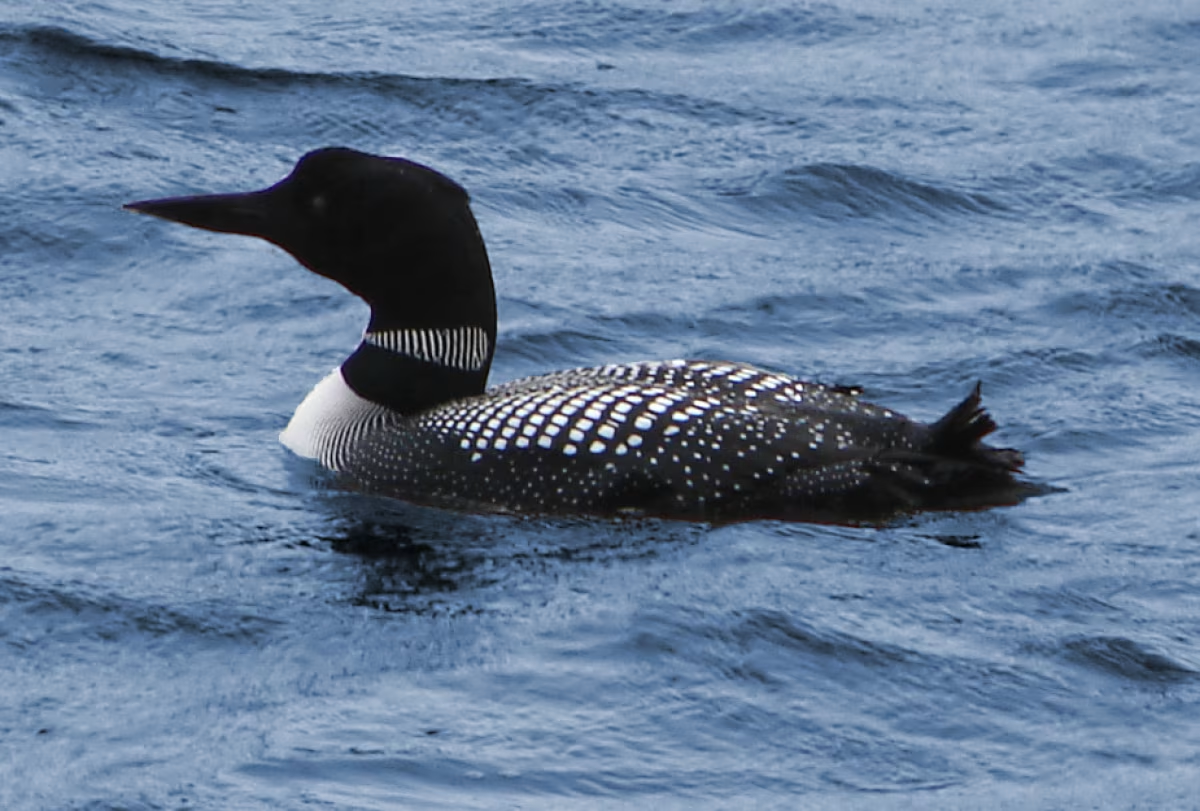Name: Great Northern Diver, Great Northern Loon (Gavia immer)
Length: 60 to 100 cm.
Weight: 1.5 to 8 (average 4) kg.
Location: Summers – U.K., Iceland, Greenland, North America. Winters – Coastlines of south North America and Europe, north-west Africa.
Conservation status: Least Concern.
Diet: Fish.
Appearance: Breeding appearance – black head, white underparts, checkered mantle (upper back and shoulders). Non-breeding appearance – brown with white fore-neck and chin. Red eyes.
How do Common Loons feed?
Common Loons can dive as deep as 60 metres per dive, remaining underwater for 3 minutes at a time. The red in their eyes helps them see underwater.
Are Common Loons social?
Common Loon adults will pair up to form a monogamous couple, both of which will defend their staked territory from other invading Common Loons.
Aside from defending their home stake they will occasionally form slightly larger groups for group feeding in a neutral territory.
How fast do Common Loons fly?
Common Loons can reach speeds of 120 km per hour.
What are Common Loon birthing rituals like?
Common Loons arrive at their breeding grounds in April through May.
Nests consist of mounds of dirt or vegetation with the middle hollowed out. The male will choose the location for the nest, then both members of the couple will help to build it.
The female will lay 1 to 3 eggs. Both parents take turns incubating the eggs for the span of about 1 month. They then take turns feeding the young once they’ve hatched for the next 2 months.
The chicks will ride around on their parent’s back for its first explorations of the area. This is thought to both help keep it warm and to avoid predation.
Chicks are able to dive only 2 days after hatching. They are competitive with each other for food, and the fights can occasionally lead to a death.

© By P199 (Own work) [CC BY-SA 2.5], via Wikimedia Commons.jpg
How long do Common Loons live?
Common Loons can live as long as 30 years in the wild.
How many Common Loons are there today?
A rough estimate puts the worldwide Common Loon population at a little over 525,000 individuals.
Do Common Loons have any natural predators?
Eggs and young are vulnerable to a number of predators – large fish, foxes, minks, gulls, corvidae (a bird family including crows, ravens, jays, and magpies), raccoons, skunks, and snapping turtles.
Adults are occasionally preyed upon by bald eagles and sea otters.
7 Cool Common Loon Facts
- The genus name Gavia is a Latin word that was originally used to describe the Smew, a small sea duck. The two birds are scientifically unrelated but both are black-and-white divers.
Immer is thought to have one of two possible origins. The first is the Latin word immergo meaning immersed, related to the bird’s diving. The other possible source is an old Swedish word emmer or immer which means “ashes”, relating to the bird’s dark colouring. - “Loon” has an interesting origin too – it comes from Scandinavian words for “lame” like the Swedish lam and it describes how the loon’s large webbed feet, placed at the rear of its body, make it less than graceful on land.
- Historic evidence suggests that the Common Loons have been around for at least 20,000,000 years, making them the oldest and most primitive example of a bird alive today.
- Unlike most birds, Common Loons have a number of solid bones (as opposed to hollow) that add weight to help them dive. However this makes it harder for them to take off, meaning that they have to use a “runway” approach of flapping and skimming along the water for a bit before they can manage to get into the air.
- When attacked or when defending their young Common Loons have been known to rush their attackers in an attempt to impale them.
- Common Loons appear on the Canadian $1 coin which is known as the “Loonie.” (A $2 coin is called the “Two-nie.”)
- Adult Common Loons can host up to 40 different types of body parasite.








